Your cart is currently empty!

HARI Official Brand Site

“Humans and macaws have always enjoyed a relationship on some level but the Mayans took this relationship to a spiritual level.”
Local legend has it that Macaw Mountain or Mo’ Witz as the Mayans would say, was named by the Mayans more than 1500 years ago. Throughout the 1000-year reign of the Mayan Empire, it was evident in daily life that the Mayans revered the splendour and beauty of the macaw and its habits.

Humans and macaws have always enjoyed a relationship on some level but the Mayans took this relationship to a spiritual level. The ruling elite and the religious community integrated the scarlet macaw into their lives and culture in so many ways that it is difficult to separate myth from reality.
The Mayans explained their creator’s eternal existence through the marriage of the snake and bird in the feathered serpent. The serpent, with a head on each end, and endowed with the birds’ ability to fly to and from the heavens, had no beginning and no end. The Macaw Mountain project is a logical extension of the relationship the Mayans had with this land, their most respected creatures and themselves. Macaws are the most common birds represented in Mayan art and architecture. The macaws and most of the Mayans have moved on from Macaw Mountain. But today, a new affiliation between the majestic ara macao and a few concerned individuals have developed a new passionate relationship reigniting the majestic scarlet macaw with Macaw Mountain and the people of central America.
This story begins in the 1980’s when Lloyd Davidson adopted two scarlet macaws left in the lurch when a bank repossessed a resort on Roatan Island. Mandy Wagner, a friend, and also a bird lover and resident of Roatan Island, developed an interest in these birds and began helping with their care. Many local Hondurans have parrots as pets and a few close encounters with other parrots and toucans impassioned her to begin looking after the unwanted and neglected parrots of Roatan Island. Gradually, Mandy added some amazons to the collection and gained the reputation as “bird lady,” and the flow of birds began in earnest.
When Mandy had to unexpectedly leave the Island in 1994, Lloyd became the primary caretaker of the growing collection that now numbered about 35 parrots. By making his hobby open to the public, he soon found that he was, quite by accident, educating the locals and other visitors about the husbandry needs of these personable birds. As the collection grew, a small park developed and was eventually opened to the public.
The park had been open about four months when Hurricane Mitch visited the island in 1998, and changed the destiny of the park’s residents. The small park was destroyed; however all the birds were safe. Just prior to the storm. Lloyd had moved the now 80+ parrots to his “Flying Fish” warehouse and all were saved. In the process of redesigning and rebuilding the park, Lloyd found that his vision and standards were changing and that the area could no longer could provide the environment he desired for his flock. The character of the island was changing; a once peaceful out-of-the-way place had become a mecca for every type of tourist and recreation associated with coral reefs and beautiful beaches. Not just from fear of another hurricane but from a desire to provide the finest habitat his companions deserved, Lloyd began searching for a more suitable environment.
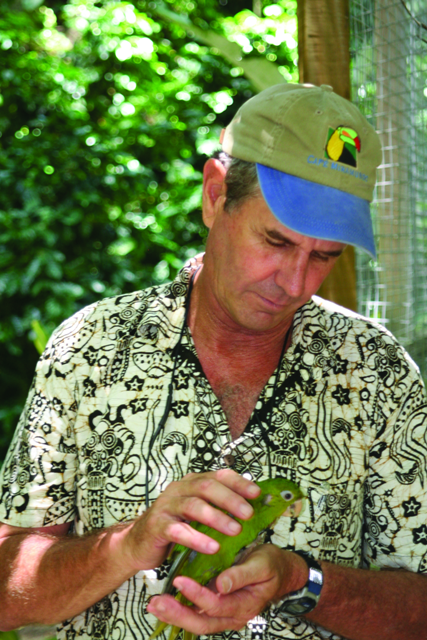
In his spare time Lloyd began the long process of finding the perfect location. After settling on the general location of Copan, and learning of the legend of Macaw Mountain, the search began in earnest. After months of searching and while driving along a 7-mile-long river valley that began, or ended, on the outskirts of Copan, Lloyd jokingly said to Pat, his business partner who was driving, “Why don’t you pull off into that parking lot so we can take a break?” The “parking lot” was nothing more than a grassy clearing on the side of the road. As they got out of the car and looked around, they began to get a feeling that this really could be a parking lot. A few minutes later, they discovered that they had happened upon a rare find, a section of uncut old growth primary forest. A few feet from the road they saw a deep secluded valley, a vociferous mountain river, natural springs, a forest of trees hundreds of feet tall and more varieties of native plants and birds than they could have imagined.

For the next few months, Lloyd visited the area every few days. Eventually, he had walked every inch of the valley and over time developed a magical vision of the ultimate parrot community. Utilizing the natural terrain and with the least possible impact on the lush tropical garden that had been growing for thousands of years, the park took shape in his mind. Huge walk-in cages where the birds could fly and visitors could walk through were the foundation of the design. A park developed around the cages. The park was to include several hill side deck-perches for visitors to enjoy the grandeur of the tropics and a restaurant that was actually a bridge over the river. The vision also included a large visitors’ centre, a café with a large deck perched over the hillside, a swimming area, and numerous walkways paved with interlocking bricks and wood decking. In the centre of it all is a large handling area where visitors can get up close and personal with macaws, toucans and many other types of parrots. For those not familiar with parrots, the handling area would offer an excellent opportunity to see and get to know them. At any one time a visitor will handle and see twenty or more friendly parrots and toucans fly and roam as if they were free. The area would be monitored by several well-trained staff that educate visitors on almost any aspect of the birds in the wild and in captivity.
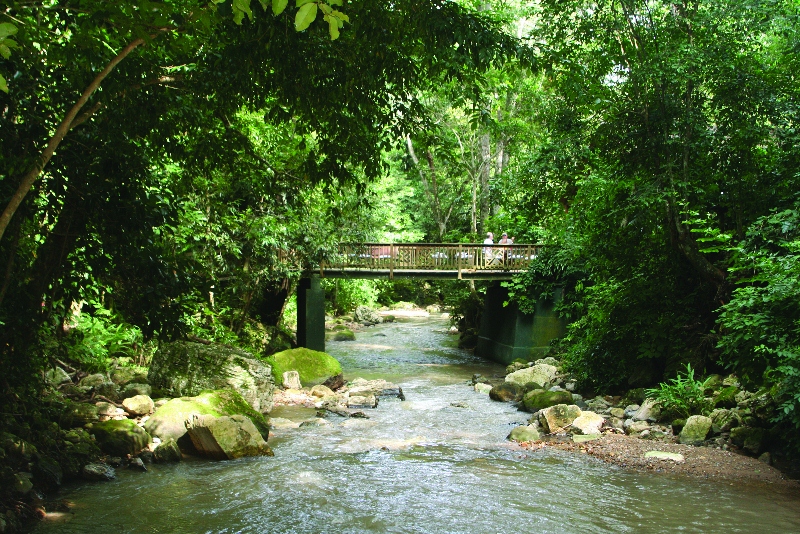
The next step was to find the owner of the land and strike a deal – not always an easy thing to do in Honduras. The land owner was an older gentleman who had vast land holdings and was well known for having no motivation to sell any of his land. Lloyd arranged a meeting with the owner at the property, and after explaining his well- developed vision for a park, how the project would preserve the natural environment and what it might do for the people of Honduras, the gentleman quoted a very reasonable price, extended his hand, and the deal was sealed with a simple handshake.
Building a park in the middle of a Central American jungle is no easy task. Lloyd had spent his life as a biologist and owner of a commercial fishing business. His fleet of boats supplied the United States with fresh red snapper served in restaurants along the east coast. This background did not supply him with knowledge of parrots, education, park management or construction. He did, however, know how to operate complicated enterprises and his passion for improving the lives of parrots pushed him to conceive a very impressive habitat for his flock and a method for making it happen.
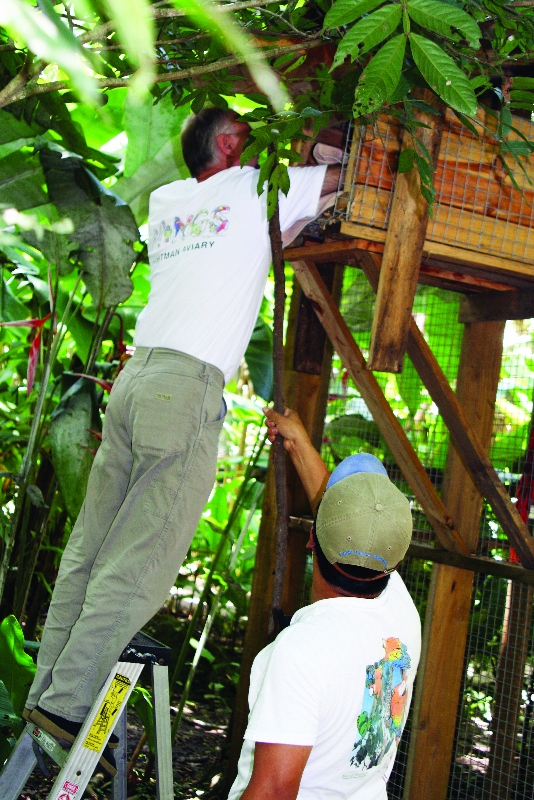
For construction advice, Lloyd turned to his long-time friend and business partner, Pat Merritt. Pat grew up in Alaska, moved to Wyoming as a young adult, settled in as a cattle rancher for 20 years, and eventually found his way into the shipping and fishing industry as a boat captain servicing the Caribbean between Honduras and the United States. Each of these areas required a great deal of “jack of all trades” engineering and construction savvy. As it turned out, this partnership provided the combination of most of the skills necessary to make this dream come true. During the parks construction, word spread quickly and the idea was well accepted by the locals and the government. Before the parks completion in 2003, additional birds began to show up. There were even cases where concerned citizens purchased birds from neighbours so they could be given a more comfortable life. At the time of this article, the park housed over 130 birds of at least 20 native species. The park’s success has already prompted plans for expansion to handle additional rescues and a breeding facility for some of the rarer species like the buffons macaw and the yellow-lored amazon.
During the construction process, Lloyd had the fortune to meet Dr. Jennifer Ahlfeldt who has a PhD in art history from Columbia University. She was there working on a project, through Harvard University, to reassemble sculptures that had deteriorated and fallen from the facade of several temples in Copan.
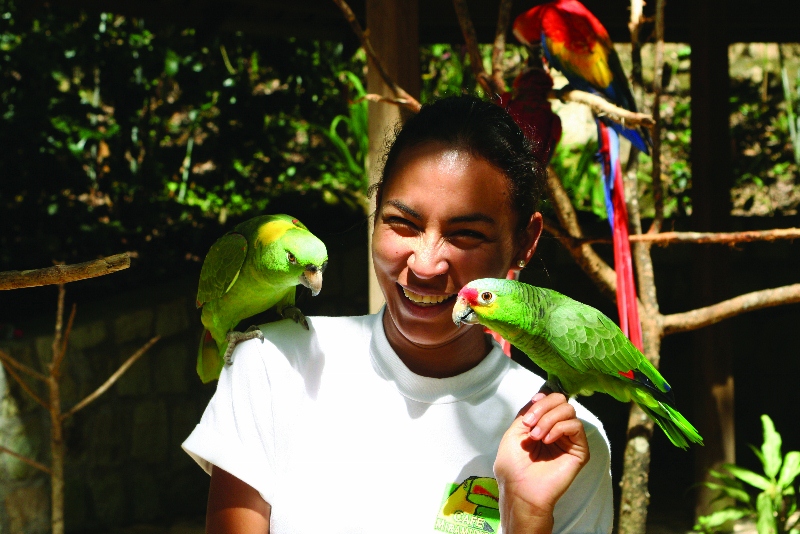
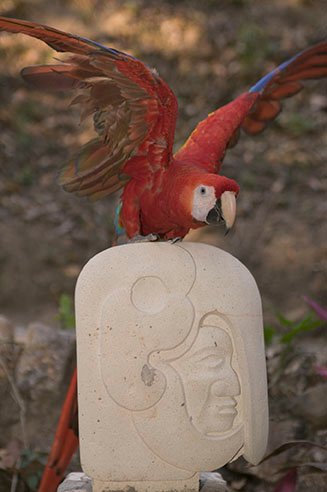
Dr. Ahlfeldt is an expert on Mayan culture and religion and developed an interest in the educational aspects of the park. She has developed a great deal of information on the relationship the Mayans had with the scarlet macaw and other birds, and has put together a collection of Mayan art that is displayed at the park. The collection consists of 6 large pictorial reproductions and some carved stone reproductions of the glyphs depicting the macaws in Mayan life. A fifty- foot-long outdoor art pavilion circles the handling arena. Along with the incredible Mayan art is highly informative text explaining the relationship not only to outside visitors but to the local population as well. Even though the primary mission is education to make life better for captive parrots, there are no warnings or admonishments about what not to do as a parrot owner. The park educates by setting a good example. As the saying goes “a picture is worth a thousand words,” and Macaw Mountain paints an incredible image of macaws and other parrots thriving in a natural habitat. This picture wakens pet bird owners’ sense of responsibility and provides awareness of just what is necessary to truly meet the needs of these intelligent creatures.
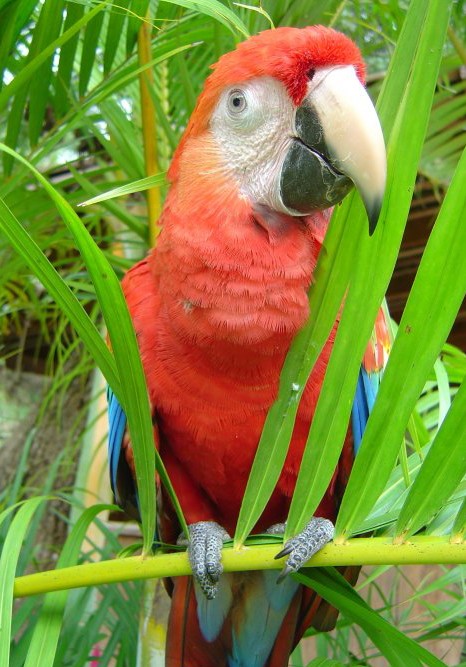
The Honduran Department of Natural Resources has recognized the park’s reputation and impact on the area and has asked for assistance in managing a population of semi-tame free ranging scarlet macaws. This flock of 20 or more scarlet macaws spends most of their time near the entrance to the Copan Ruins park where they enjoy free meals and gladly pose for photographs. If you find yourself in the area and have an interest in parrots, butterflies, lush tropical jungles, the sound of mountain spring water cascading through a mountain valley, or just want to spend a little time in paradise, you will not want to miss Macaw Mountain.
by: Steve Hartman
The Parrot University
TheParrotUniversity.com
9000 Cheshire Road, Sunbury, Ohio 43074
740-965-1964
Find Macaw Mountain on Facebook!
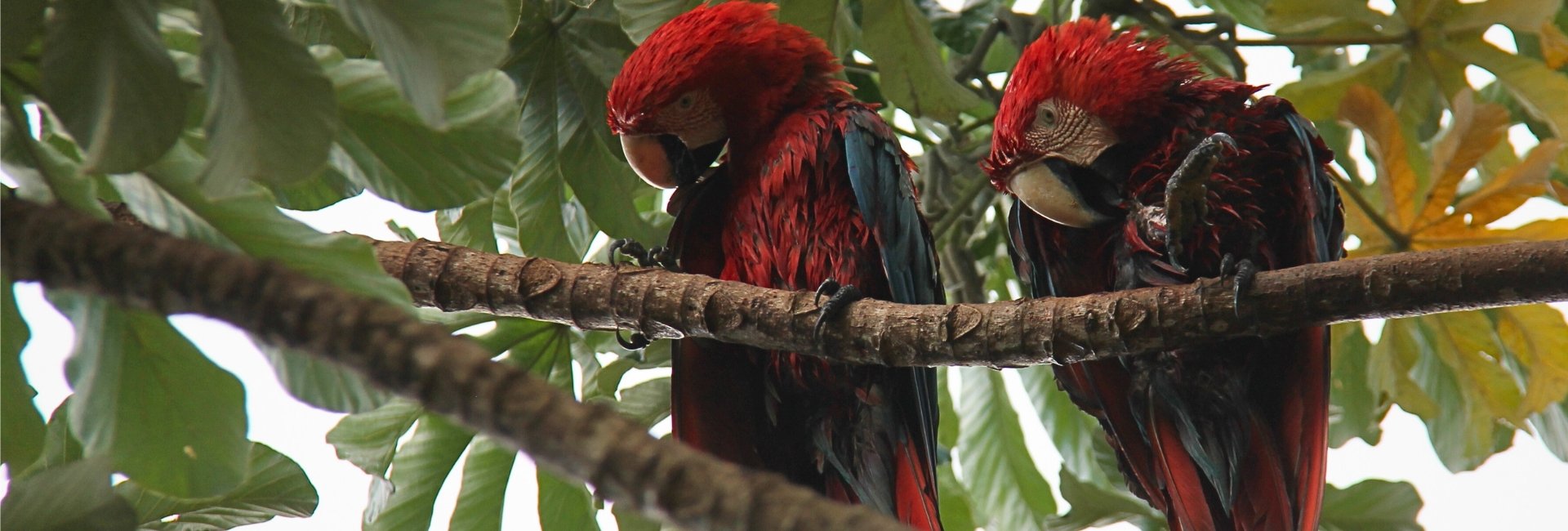
We take pride in setting the standard for parrot care in captivity and supporting conservation projects in the wild. That’s why we work closely with top conservation programs to help protect parrot species and their natural habitats for for generations to come.